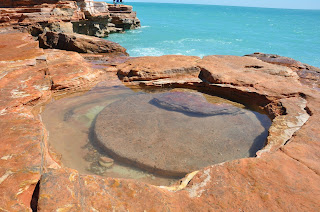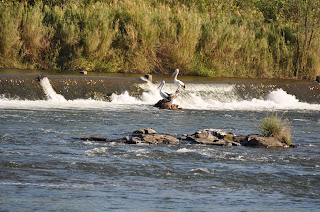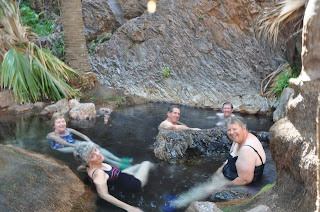Broome: 28 July
The final day of our tremendous tour
of the Kimberleys was a sightseeing trip around Broome, including Gantheaume
Point with Anastasia’s Pool and the mock-up of the dinosaur footprints, Chinatown,
the Japanese cemetery and the Pearl Luggers Museum. Guess who got to hold one of the biggest pearls ever?
Our driver for this trip was Andrew and he was extremely knowledgeable about the history and current situation of Broome. We saw the models of the dinasour footprints (the real ones were under 8 metres of sea water) and Anastasia's pool.
Our driver for this trip was Andrew and he was extremely knowledgeable about the history and current situation of Broome. We saw the models of the dinasour footprints (the real ones were under 8 metres of sea water) and Anastasia's pool.
After lunch we all relaxed. Some of us caught a wave or two at Cable
Beach while others enjoyed the pools at the resort. Later in the day, we watched the sun set along
with a large number of other people. It
is evident that Cable Beach sunsets are quite an institution!
The final activity of our tour was our
farewell dinner – where we thanked Paul for his magnificent efforts in taking
us for 3,600 km through the Kimberleys on such an unforgettable journey.
As we reflect on our tour, we realise that we have been on quite an adventure through some of the most remote and difficult to access country in Australia - the Kimberleys in north-west Western Australia.
Kimberley Reflection
As travelling to the Kimberleys was such a long standing ambition and spending time in the Kimberleys was such an integral part of our trip, it is worthwhile making some brief reflections on what our trip through the Kimberleys has involved and what it has meant to us.
The
first aspect that became apparent is that there is not one Kimberley but
various ‘Kimberleys’ – there is east Kimberley, there is west Kimberley and
there is central Kimberley. Each of
these regions has its own identity and its own character, although there are
clearly overlaps in a number of respects.
There is the Shire of Derby West Kimberley, the Shire of Wyndham East
Kimberley and, in the more central area, the Shire of Halls Creek. Of course, one of the main factors is the
sheer size of this region and the need to break it up into more manageable
administrative areas.
The
vastness of the Kimberleys can only be properly realised by moving around the
region. The road distance from Broome to
Kununurra, for example, is 1,067 km.
While this is a good quality sealed road, the locals still don’t refer
to travel in terms of distance but in terms of time: for example, it takes 11 hours to drive this
journey. This approach is appropriate
when considering the many unsealed roads:
the 60 km along the extremely rough Port Warrender track take 2 hours
and the 50 km into the Bungle Bungles take nearly 2 hours. When we flew from Broome to the Horizontal
Falls in Talbot Bay, it took over an hour – and that only covered a small part
of the west Kimberley!
It
was not until we set off along the Gibb River Road that the extent of the flat
savannah and grazing country became apparent.
Rather than the rugged country with mountains and gorges we might have
been expecting, much of the Kimberleys is flat or undulating. Moreover, there are various plateaus – such
as the Mitchell Plateau and the Gardner Plateau and travel across the country
can involve negotiating ‘jump ups’: that
is, jumping up from one level to the next, often involving quite steep
climbs. Of course, if you ‘jump up’, you
inevitably have to ‘jump down’ as well.
The
geology and geography of the Kimberleys are quite fascinating. The rocks of the region are some of the
oldest on earth and the various landforms are amazing as is the way in which
erosion and other forces have shaped the landscape. The consequences of these actions now see
many fabulous rivers, gorges, waterfalls and permanent waterholes scattered
across the Kimberleys. The flora is
equally interesting, with the extra-ordinary boabs, the kapok bush with its
bright yellow flowers, the unique livistonia palms on Mitchell Plateau and the
elusive Kimberley rose being a small selection of many plants that are seen
across the Kimberleys.
Associated
with the issue of remoteness is the question of the quality of some of the
roads. One of the beautiful features of
the Kimberleys is the fact that to use road transport requires 4WD in many
instances. In some parts, however, such
as at the north-eastern end of the Gibb River Road, work is in progress to
upgrade this section of road to enhance access to such areas as El Questro and
Emma Gorge.
In
our view, part of the inherent beauty of the Kimberleys is the natural
ruggedness of the region. It is this
ruggedness, combined with being so remote, that makes the Kimberleys such a
desirable region to visit – and it is these characteristics which should guide
how this region is to be managed. In our
view, the principle should not be one of there being ease of access. Rather, the guiding principle should be that,
if people want to visit the Kimberleys, they must make appropriate preparations
to do so. Upgrading and sealing roads
will diminish the essential character of the Kimberleys. Nevertheless, we can see increasing pressure
being applied to upgrade roads. The key
question is to achieve the appropriate balance in responding to these
pressures. Of course, there will be
times when, despite the best efforts of humans, a good wet season may create
havoc on infrastructure throughout the Kimberleys – and there will be little we
can do about that!
If
possible, everyone should attempt to visit the Kimberleys. The variety of the region is astounding, the
beauty of the region is magnificent and the influence of indigenous peoples
throughout the region is fascinating – reaching back over thousands of
years. It is well worth seeking an
understanding of all that the Kimberleys have to offer. It also will be interesting to see how the
Kimberley region continues to develop – with the expansion, for example, of the
irrigated area around Kununurra and the development of new mining
projects.
As we reflect on our tour, we realise that we have been on quite an adventure through some of the most remote and difficult to access country in Australia - the Kimberleys in north-west Western Australia.
Kimberley Reflection
As travelling to the Kimberleys was such a long standing ambition and spending time in the Kimberleys was such an integral part of our trip, it is worthwhile making some brief reflections on what our trip through the Kimberleys has involved and what it has meant to us.
Given
all the characteristics of the Kimberleys, it is not surprising that many parts
are quite remote. Some, such as Cape
Leveque, the Mitchell Plateau and Kalumburu can be accessed by road – albeit by
using at times unformed and irregularly-maintained roads which are very slow
and require extremely careful negotiation according to the conditions. Some parts are only accessible by air or by
ship – and, in the wet season, access may be even more restricted with road
closures and inclement weather.
This
creates a dilemma: should the roads
remain as gravel roads or should they be upgraded? There are various issues with retaining roads
essentially as they are at present, with the many low level crossings of water
courses, the road closures in the wet season, some very rough sections and the
cost of maintenance – all of which mean that only people who have made the
proper preparations can travel through the Kimberleys by road. Alternatively, should at least some roads be
upgraded and even sealed to increase access for more people?


















































